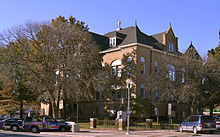Adair County, Missouri
| Adair County, Missouri | |
|---|---|

Adair County Courthouse in Kirksville
|
|
 Location in the U.S. state of Missouri |
|
 Missouri's location in the U.S. |
|
| Founded | January 29, 1841 |
| Named for | John Adair |
| Seat | Kirksville |
| Largest city | Kirksville |
| Area | |
| • Total | 569 sq mi (1,474 km2) |
| • Land | 567 sq mi (1,469 km2) |
| • Water | 2.1 sq mi (5 km2), 0.4% |
| Population (est.) | |
| • (2015) | 25,378 |
| • Density | 45/sq mi (17/km²) |
| Congressional district | 6th |
| Time zone | Central: UTC-6/-5 |
| Website | adaircountymissouri |
| Adair County, Missouri | ||||
|---|---|---|---|---|
| Elected countywide officials | ||||
| Assessor | Donnie Waybill | Republican | ||
| Circuit Clerk | Linda Decker | Democratic | ||
| County Clerk | Sandra Collop | Democratic | ||
| Collector | David O. Erwin | Democratic | ||
|
Commissioner (Presiding) |
Stan Pickens | Republican | ||
|
Commissioner (District 1) |
Carson Adams | Democratic | ||
|
Commissioner (District 2) |
Mark Thompson | Republican | ||
| Coroner | Brian C. Noe | Republican | ||
| Prosecuting Attorney | Matt Wilson | Democratic | ||
| Public Administrator | Rhonda Noe | Republican | ||
| Recorder | Pat Shoush | Republican | ||
| Sheriff | Robert T. Hardwick | Republican | ||
| Surveyor | David W. Borden | Democratic | ||
| Treasurer | Lori J. Smith | Republican | ||
Adair County is a county located in the northeastern part of the U.S. state of Missouri. As of the 2010 Census, the population was 25,607. Its county seat is Kirksville. The county was organized January 29, 1841 and named for Governor John Adair of Kentucky.
Adair County comprises the Kirksville, MO Micropolitan Statistical Area.
The first permanent settlement in Adair County began in 1828. Many of the first settlers were from Kentucky, and Adair County was named for John Adair, a respected Governor of Kentucky. This was 25 years after the Louisiana Purchase, seven years after Missouri was granted statehood, and four years after the Sac and Fox Native American tribes surrendered their claims to the land. The original settlement was called "Cabins of White Folks," or simply, "The Cabins," and was located six miles (10 km) west of present-day Kirksville along the Chariton River.
The Big Neck War: In July 1829, a large party of Iowa (or Ioway) Native Americans, led by Chief Big Neck, returned to their former hunting grounds in violation of treaty. One of the Ioway's dogs killed a pig and they threatened (or insulted, according to some sources) the white women. The settlers sent messengers south to Randolph and Macon counties asking for help. Captain William Trammell responded with a party of some two dozen men to help. By the time of their arrival, the Ioways had left the area and moved upriver into what is now Schuyler County. Trammell's force, augmented by several of the men from The Cabins, pursed and engaged the Ioway at a place called Battle Creek, killing several Native Americans including Big Neck's brother, sister-in-law, and their child. The Trammell party lost three men in the skirmish, including Captain Trammell himself, and one additional casualty died of his wounds shortly afterward. The surviving whites returned to the cabins, collected the women and children, and headed south for the Randolph County settlement of Huntsville. Later, a group of militia under General John B. Clark pursued and apprehended Big Neck and his braves, capturing them in March 1830. Soon, several escaped from jail and fled to the current state of Iowa; however, Big Neck himself and the remainder were put on trial by a grand jury of Randolph County. The jury found on March 31, 1830, that: "After examining all the witnesses, and maturely considering the charges for which these Iowa Indians are now in confinement, we find them not guilty, and they are at once discharged." The acquittal of Big Neck seemed to have brought the war to a peaceful, if uneasy, conclusion. A few months later, white settlers returned to The Cabins, this time in greater numbers, and this time to stay permanently. The outbreak of the Blackhawk War in 1832 again caused consternation among the early settlers although all fighting was hundreds of miles away in present-day Illinois and Wisconsin. To ease fears in the area, militia units were dispatched and two small forts were constructed. One, Fort Clark, was located on high ground adjacent to The Cabins. Several miles to the northeast, another detachment of troops established Fort Matson. After months of no hostile Native American activity in the Adair County area, both forts were abandoned. The site of Fort Clark is now marked by a large boulder and plaque, while the Fort Matson site was later the location for a church, name corrupted to Fort Madison (not to be confused with the Iowa city). The Fort Matson/Madison Cemetery still remains.
...
Wikipedia
